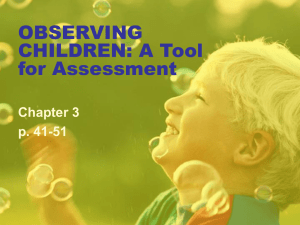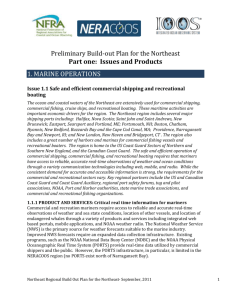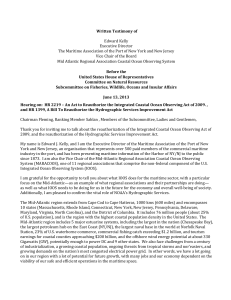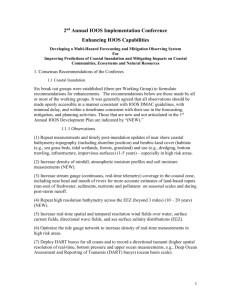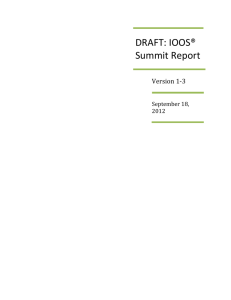Executive Summary
advertisement
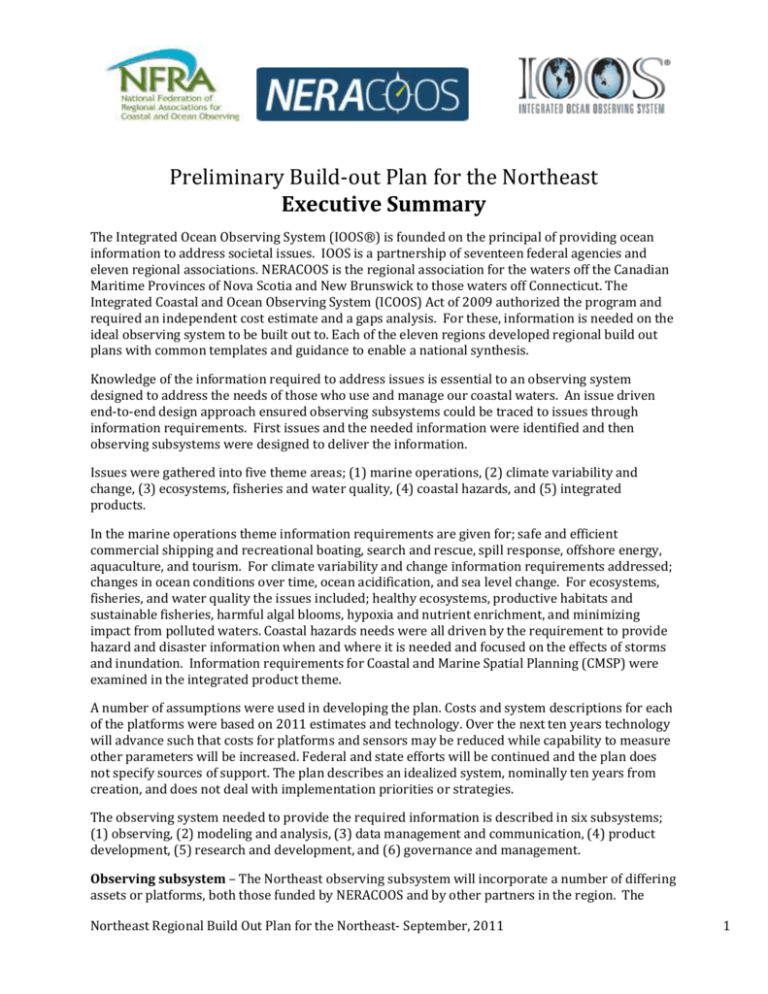
Preliminary Build-out Plan for the Northeast Executive Summary The Integrated Ocean Observing System (IOOS®) is founded on the principal of providing ocean information to address societal issues. IOOS is a partnership of seventeen federal agencies and eleven regional associations. NERACOOS is the regional association for the waters off the Canadian Maritime Provinces of Nova Scotia and New Brunswick to those waters off Connecticut. The Integrated Coastal and Ocean Observing System (ICOOS) Act of 2009 authorized the program and required an independent cost estimate and a gaps analysis. For these, information is needed on the ideal observing system to be built out to. Each of the eleven regions developed regional build out plans with common templates and guidance to enable a national synthesis. Knowledge of the information required to address issues is essential to an observing system designed to address the needs of those who use and manage our coastal waters. An issue driven end-to-end design approach ensured observing subsystems could be traced to issues through information requirements. First issues and the needed information were identified and then observing subsystems were designed to deliver the information. Issues were gathered into five theme areas; (1) marine operations, (2) climate variability and change, (3) ecosystems, fisheries and water quality, (4) coastal hazards, and (5) integrated products. In the marine operations theme information requirements are given for; safe and efficient commercial shipping and recreational boating, search and rescue, spill response, offshore energy, aquaculture, and tourism. For climate variability and change information requirements addressed; changes in ocean conditions over time, ocean acidification, and sea level change. For ecosystems, fisheries, and water quality the issues included; healthy ecosystems, productive habitats and sustainable fisheries, harmful algal blooms, hypoxia and nutrient enrichment, and minimizing impact from polluted waters. Coastal hazards needs were all driven by the requirement to provide hazard and disaster information when and where it is needed and focused on the effects of storms and inundation. Information requirements for Coastal and Marine Spatial Planning (CMSP) were examined in the integrated product theme. A number of assumptions were used in developing the plan. Costs and system descriptions for each of the platforms were based on 2011 estimates and technology. Over the next ten years technology will advance such that costs for platforms and sensors may be reduced while capability to measure other parameters will be increased. Federal and state efforts will be continued and the plan does not specify sources of support. The plan describes an idealized system, nominally ten years from creation, and does not deal with implementation priorities or strategies. The observing system needed to provide the required information is described in six subsystems; (1) observing, (2) modeling and analysis, (3) data management and communication, (4) product development, (5) research and development, and (6) governance and management. Observing subsystem – The Northeast observing subsystem will incorporate a number of differing assets or platforms, both those funded by NERACOOS and by other partners in the region. The Northeast Regional Build Out Plan for the Northeast- September, 2011 1 expectation is that assets funded by state and federal programs such as the National Data Buoy Center will continue to be supported in the future. The NERACOOS priorities will be to continue to support multipurpose buoys and to increase the number of nearshore or estuarine platforms, expanding the array offshore to fill spatial gaps and augmenting with additional sensors to fill data gaps. The nearshore / estuarine stations will include both buoys and shore / pier based installations. Shore based stations will also be used to remotely observe surface currents with high frequency radar, both long range units for offshore areas and short range units for high-traffic nearshore waters. Additional efforts will include a ship-based, spatially fixed sentinel station program to provide pelagic and benthic observations at greater frequency than other broader scale state and federal programs and autonomous vehicles to provide greater spatial coverage. Spatial coverage of regional water-level measurements will be increased with both fixed and moveable assets. Continued measurements of river discharge and other properties with stream gauge stations remain important. Single purpose platforms will continue to be necessary where they are cost efficient or sensors are unable to be integrated on multipurpose installations. Platforms of opportunity, both mobile and fixed, will provide access to the marine environment in an efficient and cost-effective manner, greatly expanding spatial and temporal resolution of key parameters. Examples include repeat-transects on ferries, observations by fishers with fixed fishing gear, and offshore energy installations. Satellite remote sensing will provide synoptic coverage of the region’s surface waters. The Pioneer Array of the National Science Foundation’s (NSF) Ocean Observatories Initiative (OOI) will provide important and complimentary information on shelf break process south of Martha’s Vineyard. The observing subsystem is closely tied to the modeling and analysis subsystem – the two providing an information system for the region. Observations are assimilated into models, filling gaps between observations with nowcasts as well as providing future conditions with forecasts. Models can inform observational strategies to minimize model uncertainties. Modeling and analysis subsystem – The NERACOOS Modeling and Analysis subsystem is based on the Northeast Coastal Ocean Forecast System (NECOFS), a coupled atmospheric, wave and ocean circulation model. Various other models are or are anticipated being nested with NECOFS including higher resolution models, such as one for Massachusetts Bay, Inundation Forecast Systems, water quality, and ecosystem models. Model outputs are available through interoperable web-based services such as the Thematic Realtime Environmental Distributed Data Services (THREDDS). With this, further specialized models, such as physical-biological models, are able to be initiated. A hydrological watershed model provides important input information for estuaries and nearshore waters. To provide a more robust modeling infrastructure modeling efforts may be transitioned to Federal agencies. However, NERACOOS will maintain a more rapidly adaptable and flexible modeling capacity that is closely tied to state-of-the-art modeling efforts. Models can inform observational strategies such that model uncertainties are minimized. Hindcasts which assimilate historical observations allow past events and trends to be studied and assessed. They also provide a range of conditions that might be expected and allow for simulation of extreme events such as hurricanes and nor’easters with changed settings such as a rise in sea level Data management and communication subsystem – A secure, robust and cost effective Data Management and Communications (DMAC) system is required to effectively integrate, manage and distribute regional observations, nowcasts and forecasts. The DMAC system will also support the Northeast Regional Build Out Plan for the Northeast- September, 2011 2 development of regional products and services developed to meet targeted end user needs. NERACOOS will adapt and develop its existing DMAC capacity to meet the emerging IOOS DMAC standards and recommendations and ultimately provide a regional capacity for data integration, management and distribution. NERACOOS makes regional ocean information from observations and models available in a variety of ways. Robust metadata is Interoperable web-based services allow for machine to machine communications. Portals facilitate human access to real time and historical information. Examples include portals for; real-time sea surface state observations for mariners, historical climate and ecosystem information for managers, and geospatial information supporting Coastal and Marine Spatial Planning (CMSP). Partnerships are important for regional information stewardship and accessibility. Important regional partners include the Northeast Coastal Ocean Data Partnership (NeCODP) and the Northeast Ocean Data Portal Working Group for CMSP. Product development subsystem – To enable information to support decisions products or tools need to be developed. This is an iterative process requiring scoping, development and refinement steps. Available funding limits the number of products that can be enhanced or developed in a given year. The products identified for development should come from the priorities identified within the various working groups. NERACOOS product development efforts can be classified into three levels based on several factors that include complexity to implement from a technical perspective and the amount of user input/engagement needed to develop requirements for the products. Research and development subsystem – To develop, operate, and maintain a fully integrated observing system that achieves the societal goals of IOOS will require continued investment in research and development (R&D). This R&D includes activities to advance our knowledge of how the coastal, oceanic, and Great Lakes waters and their ecosystems function, to develop the sensors and platforms necessary to rapidly detect changes in the ecosystem and its capacity to provide goods and services, and to develop the tools necessary to predict such changes. Although IOOS is aimed at operational observing systems rather than R&D, the Regional Associations have a unique role in identifying and prioritizing the regional requirements for R&D, as well as the necessary transitions from research project to pilot project to pre-operational activities to operational systems. Education and training subsystem – NERACOOS engages stakeholder groups through tailored training and education activities as well as product development. Education stakeholders include those in both formal (K through graduate school) and informal (museums, aquaria, and science centers) settings. Other stakeholders include marine resource managers, public health officials, energy industry, fishermen, boaters, tourism industry, emergency responders, maritime operations, real-estate and insurance industry. Training the next generation of ocean observing professionals is essential to the ongoing operation and development of ocean observing systems such as NERACOOS. Governance and management subsystem – The administration and management of NERACOOS requires dedicated full time staff and contract support. Regular operations include administration of the organization (financial and personnel management, legal support, office space and equipment, etc.), support for the Board of Directors, Strategic Planning and Implementation (SPI) Team, and working groups, as well as management of the observing system and other duties related to the management and oversight of the organization. Staffing levels will depend on the size of the observing system. Northeast Regional Build Out Plan for the Northeast- September, 2011 3







